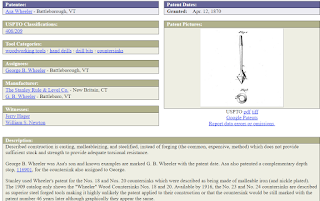So instead here is a post on some tools that recently "Followed me home" Tm :-)
You know, I just had to play with them... These tests were with the tools as found, I did not touched up the cutting edges (but I will later)
But first, lets introduce the tools in questions:
The bits
From T-B
Stanley No 22 Dowel sharpener, and
Stanley No 18 Countersink
STANLEY No 18 Countersink, brace bit, nickel plated.
This countersink design features an hollow head and a cutting lip formed by a cut after the casting.
Hard to see, but the inside of the bowl has
a pretty rough casting surface left
Cutting edge being formed by a single cut
In order for it to work, that cutting edge must
protude slightly from the other side of the cut.
There is evidence of file work on that side to lower the edge.
The cutting lip, thus made is sticking out slightly.
This results in a shaving action rather than a scraping action as typical of most countersinks models. The end results are a lot more smooth surface left without ragged tear outs.
This particular bit was manufactured by Stanley 1872-1933
But it was first produced by GB Wheeler. US Patent 101796 was assigned to Asa Wheeler on Apr 12th 1870. This design was first produced by GB Wheeler and then Stanley.
Hence the earlier models are stamped G.B. WHEELER,
then later on Stanley in various scripts
G.B. WHEELER, and
PAT'D APR 12 1870
These 3 pics from EBay
When did the change over took place? I have yet to found out...
Somewhere between 1909-1914. If anyone knows, please chimes in.
The 1909 catalog shows only the Wheeler countersink, and the 1914 shows the Stanley Nos.
It does shows up in the Stanley cat No 34 of 1914 (LAP reproduction)
Notice there are 4 numbers?
These countersinks are showing as No 18, 20, 23, 24
The differences?
No 18 is Nickel plated
No 20 is same thing with the addition of a depth gauge
No 21 not listed
No 22 is the dowel sharpener will see next.
No 23 same as 18 except finish is "black forging"or blued steel
No 24 same as 20 except finish is "black forging"or blued steel
In the Melhuish catalog of 1925.
Notice the improved pattern:
Double lip countersink
So how does it work?
Well first we need some sort of hole, in order to countersink it...
Will be using this chairnaker brace with a fixed spoon bit
The throw is about 2-1/2 inch (5 in sweep)
The bit is a tad more than 1/4 in
Cut effortlessly in cherry wood.
Notice how the piece is secured down? Good glue joints :-)
Nice chips, shaped like a ball
Did a pretty good , clean hole
Finally, we can use the countersink...
Work pretty clean also...
Now lets try the No 22 Dowel sharpener
Manufactured between 1892 to 1953.
Was changed to a round shank in 1953, for uses in electric drills
Work like a pencil sharpener
Does a pretty good job, as is. Both could be improved somewhat by a quick sharpening. In both cases, we only have to file the cutting lip.
There you have it, two very useful additions to any brace bits arsenal.
Bob, who managed a quick trip in the shop in between everything else...






















Thanks for sharing. I didn't even know they existed.
ReplyDeleteTake Care,
Chris from Florida
Are the dowel formers one size fits all? Reading your post makes me regret passing on all these countersinks I have seen. I'll snag the next one I come across.
ReplyDeleteYou are welcome Chris
ReplyDeleteBob
Yes Ralph, one size fits all , since we are talking strictly about pointing various sizes of dowels.
ReplyDeleteFor bigger sizes, round tenons for example, we used a pointer. I got 3, biggest one being 2-1/2 in capacity
Bob
wow thankful i came across this post, you really helped me. Im currently working on a project myself and was looking for something that would do this. Im actually lucky, because wouldn't be even building in the first place, its all thanks to my friend David for showing me this 16,000 woodworking plans https://tinyurl.com/y9ydf3sa
ReplyDeleteBots keep getting smarter.......
DeleteInteresting stuff, Bob. As usual.
ReplyDelete